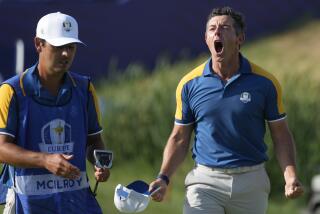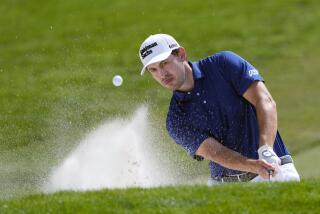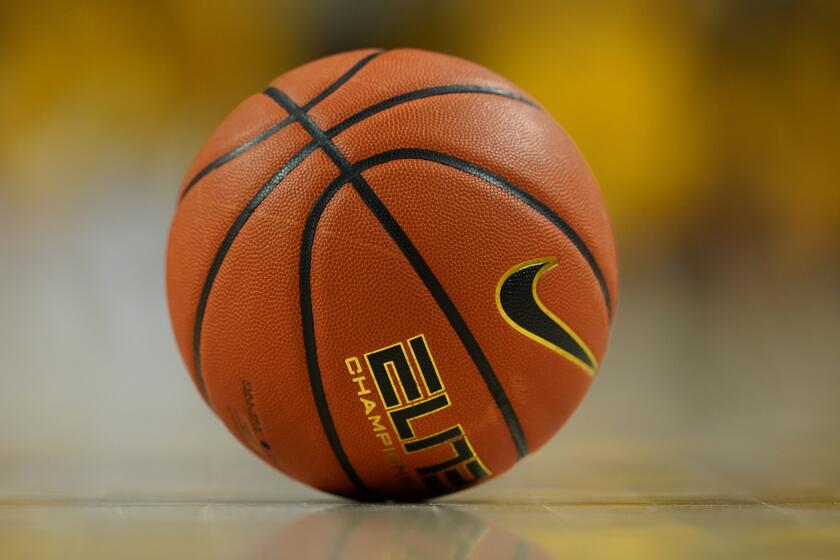SEVE BALLESTEROS
- Share via
You are a king by your own fireside, as much as any monarch in his throne.
--Miguel de Cervantes of Don Quixote
*
If Cervantes were still writing, his hero would be Don Seve, tilting at various European and American PGA tour windmills and taking on the Ryder Cup Committee in his spare time.
Seve Ballesteros has been a swashbuckling hero with a keen sense of right and wrong, even if what was right for him was wrong for everyone else. He honed his game with a three-iron as a kid in northern Spain and took it to the highest level, beating real and imagined villains.
And this weekend in southern Spain, the Ryder Cup becomes the Seve Ballesteros Cup, and he would have it no other way.
“It is very possible that if I hadn’t played in the 1983 match, the Ryder Cup would not be what it is now,” Ballesteros says in his biography, “Seve: Ryder Cup Hero.”
“It is possible that the event would have disappeared altogether. It is bad that I have to say so, but I have to because no one else does.”
Ballesteros was 26 in 1983--four years after he and countryman Antonio Gallardo, whose son is on this year’s team, were the first players from the European continent to play in the Ryder Cup. Before 1979, the U.S. team dominated one from Great Britain, losing only three times since 1927.
Ballesteros was two years past a duel with the European PGA Tour over appearance money that no one really won.
He was a two-time Masters winner and had already won two dozen international events.
As he addressed a ball just under the lip of a bunker on the final day of the ’83 Cup, he slashed a three-wood 245 yards to the fringe of the 18th green at PGA National, then made an improbable up-and-down to halve a singles match with Fuzzy Zoeller.
The Americans won, 14 1/2-13 1/2, but the Ryder Cup would never be the same.
Neither would European golf.
“Here is a man who personally grabbed Europe by the scruff of the neck and made it believe it could compete,” New Zealand’s Frank Nobilo says in Golf World magazine. “He is their Arnold Palmer.”
Well, sort of. Palmer has never felt the need to toot his own horn.
“Seeing Sandy [Lyle] and Nick [Faldo] win the British Open and watching Bernhard [Langer] win the Masters, I give a little credit to myself,” Ballesteros says in “Seve.” “I think I was the one who proved we had the ability to win majors. I think I helped give confidence to the European players.”
He’s right, for after Ballesteros had won at Greensboro in 1978--becoming the first foreign player to win a tournament the first time he teed it up on the American tour--and after he had won two Masters, European players had a Trans-Atlantic reference point. They had beaten him on their tour, he had beaten the Americans. Why couldn’t they?
The Europeans did in the 1985 and ’87 Ryder Cups, feeding on Ballesteros, who by then had his own problems with the United States.
Mainly, he had a problem with Deane Beman, head of the U.S. PGA Tour, who had thrown Ballesteros off his circuit after the 1985 season because he had played in only nine events.
The rule said 15, but Ballesteros fashioned a conspiracy in his own mind: American players didn’t want him because he was taking their money.
Ballesteros had 26 sponsors’ exemptions for 1986 U.S. tournaments he couldn’t play.
His mind-set has lingered. Said Ballesteros to Langer after Langer had won the 1985 Masters, “I am happy that it was one of us Europeans that won and not one of them.”
It has fueled his play in the Ryder Cup, in which he is 19-12-5 in better-ball, alternate-shot and individual matches, and in which he has become renowned for his coughing on Paul Azinger’s backswing, challenges to officials’ rulings and eagle-eyed attention to compression changes in Americans’ golf balls.
It’s all part of his approach to the game.
“If you ever feel sorry for somebody on a golf course, you better go home,” says Ballesteros, a suspicious and very private man who has earned millions of dollars, but few friends, playing golf.
“If you don’t kill them, they’ll kill you.”
He has killed plenty with Olazabal, winning 12 of 15 possible Ryder Cup team-play points.
That success prompted the European Ryder Cup Committee to award the matches to the Valderrama Golf Club in Sotogrande, where the event will be held on the continent for the first time.
It was a reward to Ballesteros--in his mind, a bit tardy.
“I’m not saying I won’t play if it doesn’t come here, but remember one thing: I would be disappointed,” he said before the 1993 matches were awarded to the Belfry in England. “I would lose a bit of my desire for the Ryder Cup. People should remember that, without the European players, there probably would be no Ryder Cup. . . . To wait for 1997 would be too late.
“I feel I have played a part in the success of the Ryder Cup. This is the first time I have asked for anything.”
It would not be the last.
Even the award of this year’s matches did not happen without incurring the wrath of Ballesteros, who wanted them for a course he designed near Cadiz. And even when the Ryder Cup Committee settled on Valderrama, and Ballesteros as captain of the European team, the angst was not over.
He unsuccessfully campaigned for four captain’s choices, rather than the two specified in the rules. He had countryman Miguel Angel Martin, who was recovering from wrist surgery, removed from the European team after he qualified to enable Olazabal to qualify on points so that Jesper Parnevik and Nick Faldo could be added as captain’s choices.
From the flag-raising at the opening ceremony to the food available at Valderrama, he wants a Spanish influence in the Ryder Cup.
Ballesteros is popular in northern and southern Spain, but the rest of his country doesn’t know him as well.
It’s not as if he’s Miguel Indurain, the Tour de France-winning cyclist. Or Raul, the Real Madrid soccer star. Or Francisco Rivera, the matador who has killed enough bulls to open his own fast-food franchise.
Ballesteros plays a game of the rich in a poor country. He’s better known in Britain.
He has played it uncommonly well--until lately--having won three British Opens, two Masters, five World Match Play Championships and 54 European tour events. But in the last two years, he has struggled, trying to turn the swing of a 40-year-old with a bad back to that of a 19-year-old.
He has played in eight Ryder Cups and now is watched by those who wonder what gamesmanship he can contribute as a non-playing captain.
“Nobody, takes the Ryder Cup more seriously than Seve,” Azinger writes in the forward to “Seve.”
And, “No player has done more than Seve to raise the stakes of Ryder Cup competition.”
And for Don Seve, the stakes in Spain are high.
(BEGIN TEXT OF INFOBOX / INFOGRAPHIC)
Seve Ballesteros Profile
* Age: 40.
* Residence: Pedrena, Spain.
* Career victories: 72 (54 on PGA European Tour).
* Major titles: British Open (1979, ‘84, ‘88), Masters (‘80, ‘83).
* Ryder Cups: 8.
* Ryder Cup record: 20-12-5.
More to Read
Go beyond the scoreboard
Get the latest on L.A.'s teams in the daily Sports Report newsletter.
You may occasionally receive promotional content from the Los Angeles Times.










